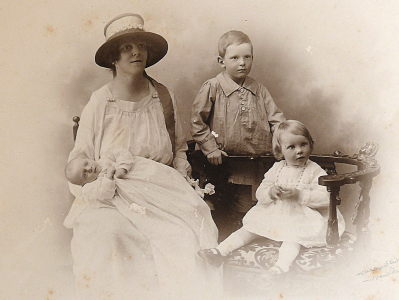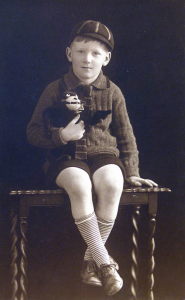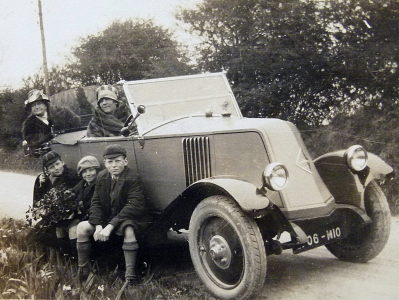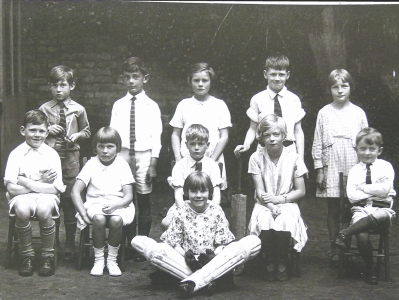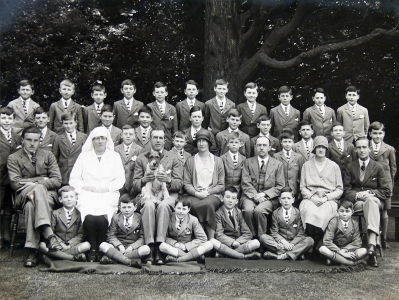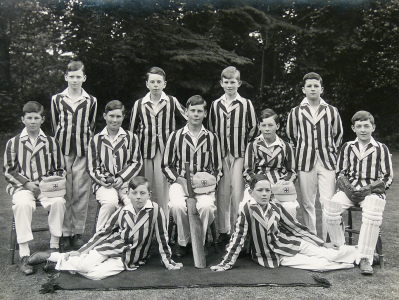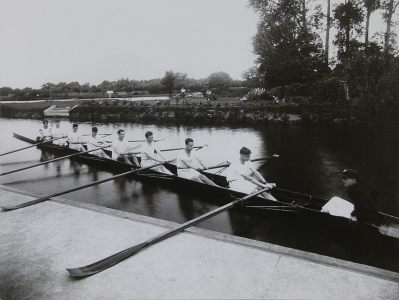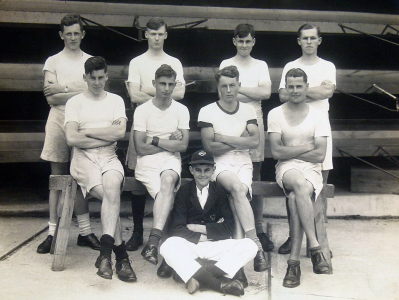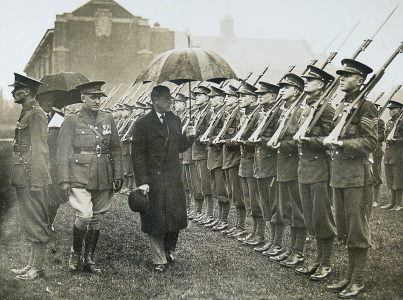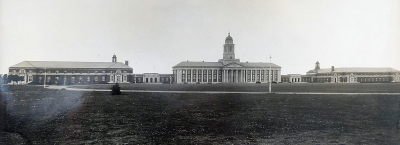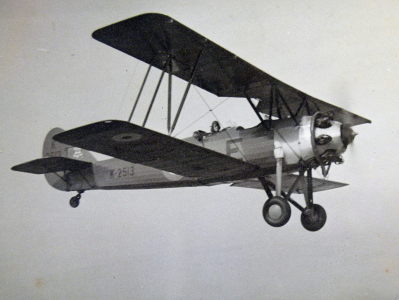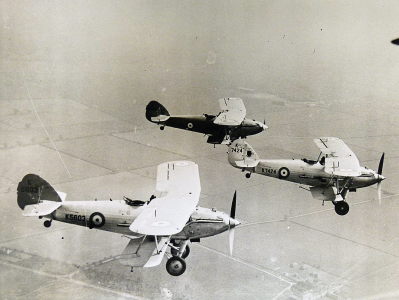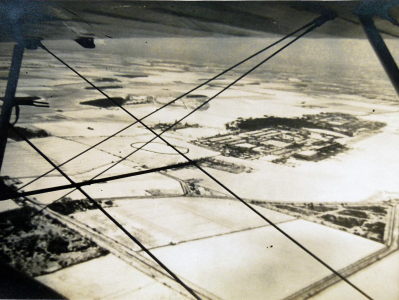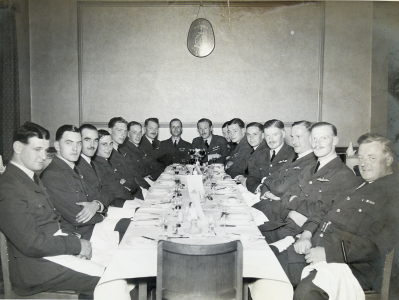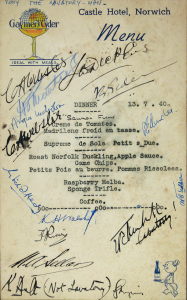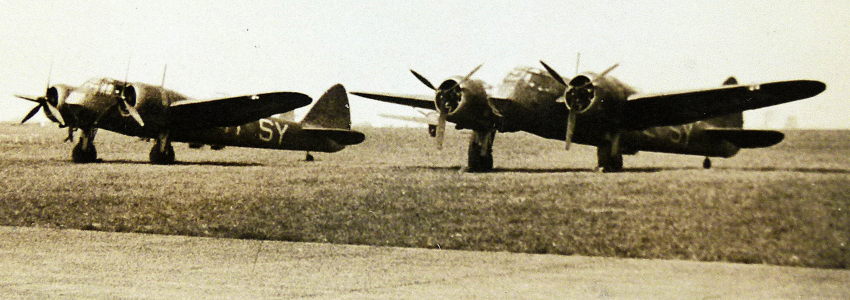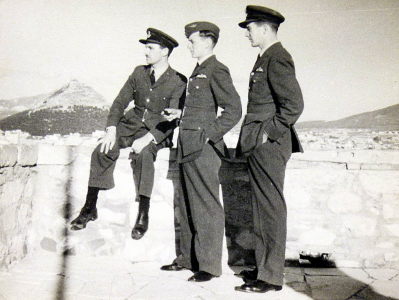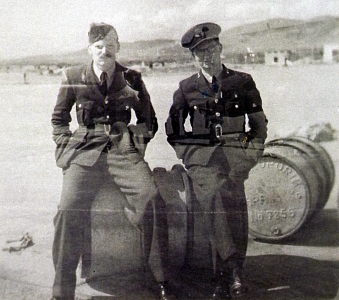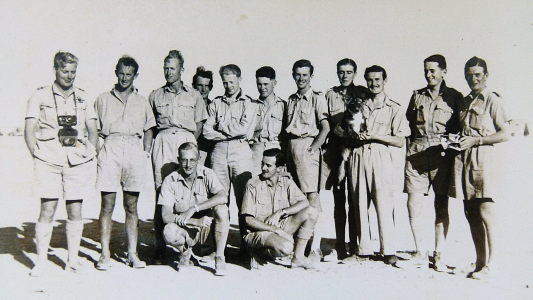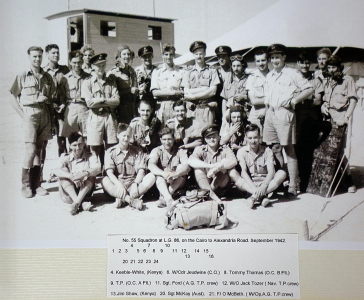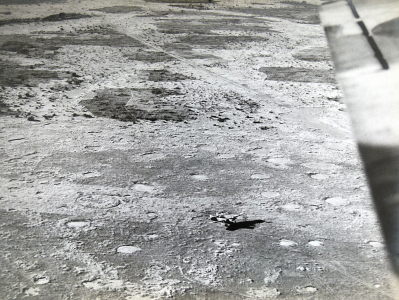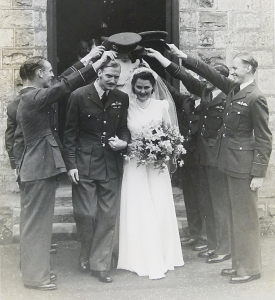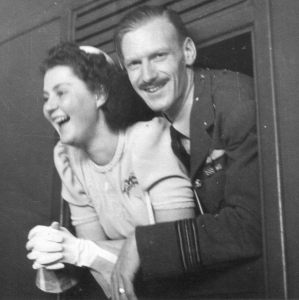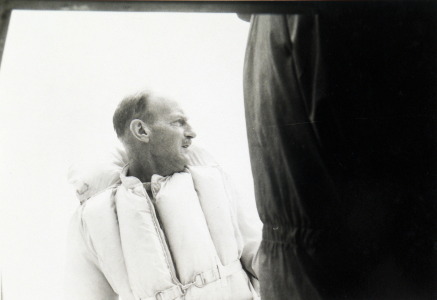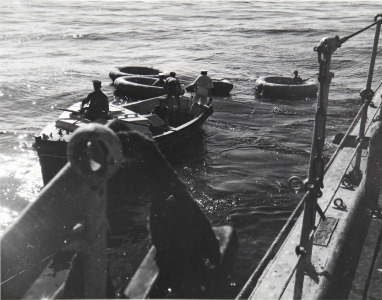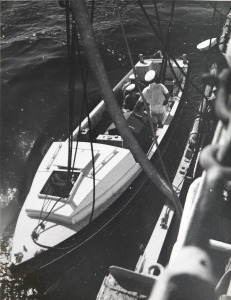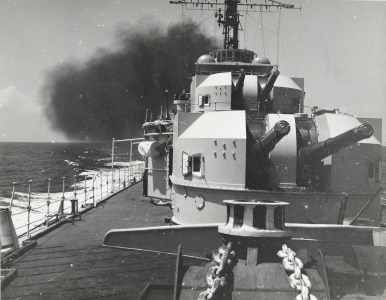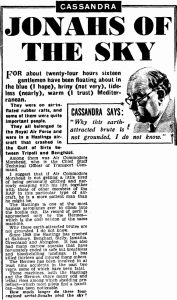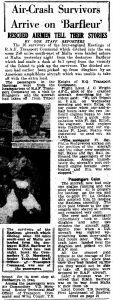Squadron Leader Frank Anthony Plinston DFCIn his own words.
|
||||||
|
||||||
|
My sister Iris and I returned to England with our mother in 1923, and went to live with Miss Mardi Gordon who ran a kindergarten in Harrow-on-the-Hill. Our mother returned to Aden and stayed until 1926 when George retired from the Army and they decided to live in France. In 1927, I left Miss Gordon's to go to a preparatory school in Horsham run by two brothers named Veysey [Note]. Iris went out to France and attended a French school near Nice on the French Riviera, later boarding at the Royal School of Bath for her final years of schooling. Holidays were spent in France, to places in the north of France Rothenouf and St. Valery en Caux, while the parents were first in a Marseilles flat, and later in St. Raphael at the Villa Madeleine which they rented long term. The journey there started at Victoria Station, London at 11 in the morning and our arrival in St Raphael was about 26 hours later. After a ferry crossing from Dover to Calais, the journey was all on the same train across France. |
||||||
|
||||||
|
Public school In 1931, I went to a public school: the Imperial Service College in Windsor. That summer, we stayed in a hotel near Teignmouth, visiting our maternal grandparents and Hugo. We saw our other grandmother quite often when we were on holiday in England but grandfather George Carter Plinston had died in 1920. I joined the rowing team at Imperial Service College; enjoying steak dinners for representing the school instead of mince that non-team members were served. I still have the tie in rowing team colours. One particularly harsh winter the school's back courtyard flooded and froze over, providing an ice-skating rink where my ice skates and skills from Harrow days were put to good use. |
||||||
|
||||||
|
||||||
|
In 1934, our parents bought a house in Ringwood on the western edge of the New Forest in Hampshire. Royal Air Force In 1937, I entered the Royal Air Force, being trained at the Royal Air Force College at Cranwell, Lincolnshire. Two years later I was posted to No. 139 Squadron at RAF Wyton, near Huntingdon flying Bristol Blenheim Mk4 Bombers. |
||||||
|
France In November, we went to France and returned to England in May 1940; the Squadron then stationed at Horsham St. Faith, near Norwich (RAF Watton). |
||||||
|
World War II broke out on 1 September 1939, and in November 1940, I volunteered to fly a Blenheim Mk4 aircraft to the Middle East. This was the quickest way to get re-enforcements there, in response to the Italian threat to Egypt and their invasion of Greece from Albania. After some delay, due to weather and activity over France, we flew to Thorney Island ready to go. My crew was Sergeant Jack Tozer, Observer and Sergeant MacLaughlin, Air Gunner. Middle East We took off from Thorney Island at about 2.00am on 2 December 1940 so that we crossed France at night. We sighted Cape Bon on the North African coast when it was full daylight, and altered course for Malta. We passed Pantelleria, keeping an eye out in case any Italian fighters got busy, and arrived at Malta after nearly eight hours. Not being able to move out of your seat for that long is quite an ordeal. We spent one night in Malta and the next day flew to Abu Sueir Airfield in Egypt in just under seven hours. We had a long range tank in the bomb bay and a manual pump in the cockpit to transfer fuel to the main tanks. Greece We stayed at Ismailia for the next two days, and we were then detailed to fly a long nose fighter Blenheim to No. 30 Squadron at Eleusis in Greece. This was close to Mount Olympus. I found that we had been posted to No. 84 Squadron at Menidi, a few miles outside Athens, to which we were transferred by road. Both No. 84 and No. 211 Squadrons were located there. The NCOs were accommodated in a tented camp in a small valley to the west, and the officers were housed in a hotel just north of the airfield and, in clearances in the edge of this, the aircraft were tucked away. We were told that there was a Royal Palace a few miles north but I never saw it. We found that No. 84 Squadron was equipped with Blenheim Mk1 aircraft, which had a shorter range than the Mk 4, and did not have the extra power of the 9lb boost. The Observer was also cramped in his seat. In other respects it was much the same and a little lighter to handle. |
||||||
|
||||||
|
The Greek Air Force occupied the hangars and buildings on the north side of the airfield but their only activity was flying an old biplane training aircraft, which later crashed in the forest on the west boundary. The war situation at this time in Greece was that the Italians had invaded the country from Albania in the north-west, and the two armies were fighting in the mountains there. The front line was fairly static, as the winter snows were hampering movement. The Greek Government did not want us to intervene directly in the front line fighting, so we were involved in bombing their bases in Albania. Our main target there was the main port, Valona, into which all their supplies from Italy came. On the 19th December 1940, I carried out my first operation with No. 84 Squadron. Nine aircraft, three Vic formations of three took off and flew up the Gulf of Corinth, then over the mountains to Valona and dropped our bombs on two ships alongside the wharves. We did not hit the ships but hits were seen close alongside in the water. We were told that the unloading of the ships was long delayed. On the return, one Italian biplane fighter came up and made a pass at us but made no hits. To Valona and return was normally made at a height of 10,000 feet, as we went over the mountains where the armies were fighting. The round trip took up to 4 hours, which was close to the limited range of the Mk 1 Blenheim. On one occasion, the formation had to turn back with fuel shortage due to head winds. In January 1941, we had bad weather and on three occasions had to return to Menidi without dropping our bombs. In February, an advance was opened at Paramythia, near an inlet on the west coast nearer the Albanian border. The weather was now improving in the mountains and we were now able to venture into the valleys and bomb the Italian lines. Our sister Squadron No. 211 moved up to this airfield and set up a tented camp. They were supplied by the Royal Navy, as they were near the coast and the roads were bad or missing. Being supplied by the Navy meant they also got English canned beer; much better than the Greek brew. No. 84 Squadron remained at Menidi, but we used Paramythia as an advanced base so we could make two sorties and return to base in one day. No. 80 Squadron was also in Greece and was based at Janina, closer to the front. On occasions, they escorted us on longer trips as when we went to the capital, Tirana, to bomb a bridge over a deep valley carrying a main road. We missed the roadway but shook up the supports. Our great advantage in Greece was that the British Pound was worth a great many Drachmas, so we were well off compared to the average citizen. Athens was our main entertainment centre. We used the main hotel there as our base. When dining, they had a large dance floor on which they provided entertainment for the diners. We also visited the Parthenon and other antiquities. Our adjutant who was knowledgeable about Greek history informed us about these and the Parthenon. The situation changed when the German Army started invading Yugoslavia and then north-east Greece. They were supported by the Luftwaffe, with a horde of Messerschmitt 109s and some Heinkel 111s. They came through a pass in the northern mountains and soon occupied the airfield at Salonika. We carried out some low level sorties against their convoys, and were lucky enough not to be caught by the Me 109s. Squadron No. 211 was not so fortunate, and lost their formation of six aircraft, their CO and Flight Commander. Menidi airfield was attacked by 15 or so Me 109s at lunch time, with our aircraft in clearings among the trees. We were fortunate in only having one aircraft written off. We had a British Anti-Aircraft battery, which was in vigorous action but they had no luck with the fast low-flying 109s. No. 80 squadron was re-equipping with Hawker Hurricane aircraft at this time, which helped when about 25 Heinkel 111 aircraft came along to bomb Athens. The Hurricanes seemed to break up the formations, and shot down several. We did not visit Athens after that, so I have no information what damage was done. |
||||||
|
||||||
|
Egypt and Iraq On 21st April, we started ferrying ground crew to Heraklion in Crete. After several trips, we were briefed on 23rd April to continue on to refuel, and then return to Ismailia. After a few odd trips around Egypt we got to Aqir, where the squadron had assembled. The Iraqis now had started shelling Habbaniya, and from Aqir we started reconnaissance flights along the desert road to Bagdad. To shorten the distance, I was detailed to take a flight to H-4. There were about six pumping stations on the oil pipe line between Mosul in Iraq and the port of Haifa in Palestine. There was another branch of the pipe line to Beirut in Syria, but that area was in French hands. Each pumping station was manned by two European employees of the oil company, plus a small village of Arabs. Each station had an airfield levelled out of the desert sand. I took 3 aircraft to H-4. A tented camp was set up for the air and ground crew, and I and the other officer pilot were given a room in the station master's house. Our task was to patrol the roads to Bagdad and Habbaniya, and check that the Iraqis were not sending convoys down to Palestine. These flights were 3 or 4 hours long, with very occasionally, the odd truck of some merchant collecting his stock. On May 7th, we had a change. At Rutbah Wells there was a fort with high mud walls and two gates for the road to pass through. This fort had been occupied by the Iraqis, and it was decided to retake it to allow the Army column, which had just been organised, to pass through. At dawn 9th May, I flew out of the sun, low over the fort and dropped a message telling the occupants to surrender or else suffer bombing. The signal of surrender was to open the gates. I hoped that with the sun behind me, we wouldn’t be shot at but we later found that a bullet had entered the nose, passed between my Observer and me and got lost somewhere in the back of the aircraft. There was no response from the fort so we were committed to bombing. There were three aircraft at H-4, all bombed up with four 250lb bombs. The Group Captain who was in command of the operation dictated that we were to drop our load one by one instead of in a stick. The fort was quite small, about 100 foot from gate to gate, and our bomb aimers were mostly accustomed to dropping a stick on a signal. So, as each did their trip, no bomb dropped inside the fort. I think the gates were damaged, and the occupiers were shaken. When the Army column arrived a few days later, there was no resistance. After our trip, we all landed back at H-3 where the Group Captain had his car. We checked the aircraft and found some bullet holes. The only real damage was a bullet hole in the outer wing tank. The self-healing was not working, so we waited for the leaking to stop before we started up and returned to H-4. Later that day the detachment returned to Aqir and re-joined the Squadron. Habbaniya On 12th May, I took a flight of five aircraft to Habbaniya. The situation there was that the Iraqi Army had stopped shelling the base, but was still camped on the hills overlooking it. It was feared that they could start their shelling at any moment. On leaving Aqir, we were warned that on arrival we should not stop on the airfield but taxi directly to a gate in the perimeter fence and into base. But the Iraqis did not carry out any more shelling. Our first operations were to cut the railway line from Mosul south to Bagdad. The first one was routine. We bombed the line with no trouble or opposition. The second sortie was also to cut the railway line but at a particular spot. The railway ran at the foot of a very large sand hill. The idea was to drop delay fused bombs into the face of the sand and start it sliding down on to the line, and blocking it. So, armed with four 250lb bombs, I took off late in the afternoon aiming to drop the bombs at dusk to delay any repair work. All went well; we arrived at the line with the setting sun, went down to sand hill height and made our run. As the first bomb landed it detonated, the other three bombs were in the air, so all we could do was to wait for the bangs. They duly arrived and we still flew on. The bomb aimers panel in the nose had a hole in it, and the wind was blowing in, and so my navigator moved back to sit at the feet of the extra man on board who was there to help us find the spot. I checked the engines and they were fine with no sign of oil leaks and sounding fine. We got back to the airfield at night and landed without any further problems. The next day, we went and viewed the aircraft and found that the belly was peppered with holes but there was no structural damage. The Germans had now sent a detachment of Me 109s and Heinkel 111s to Mosul airfield. The bombers raided Habbaniya. Being a very large area, they appeared not to have any firm target, and did not cause much damage. They had sent some Messerschmitt 110s to Mosul, and on one occasion six arrived to beat up the airfield. There were five Blenheims lined up, ready to take off on a bombing raid. I think one was hit by a few bullets, and so had to retire, but no further damage was done. I was in a truck seeing them off, and not even the truck was hit. It would seem that only inexperienced pilots were sent. We went and bombed Mosul airfield, and when we went there later, we found a burned out Heinkel. The bombers also made a raid on the base, but seemed to drop their bombs on the base as a whole, without any specific target, such as the hangars. The Iraqi Army was now ordered back to their base in Bagdad, and started moving. All the available aircraft were now bombed up, and went to help them on their way. They had to cross the river by the only bridge at Fallujah, only a few miles away. We had strict instructions to bomb the troops and trucks, but on no account to damage the bridge, as this would prevent our troops, who were now close, from going after them to Bagdad. As they had done when the first shelling started, the training aircraft, Oxfords and Harvards were all put into service and the skies over Fallujah were full of all sorts of planes. After the great retreat, we bombed a few Army outposts, but the revolt was effectively over. We also went up to Mosul and bombed the aircraft there to help the Germans on their way. Mosul Airfield No. 84 Squadron now moved to Mosul airfield, in preparation for taking part in the invasion of Syria, then held by the French, who were helping the Germans. My first and only operation from Mosul was to lead three aircraft to bomb Aleppo airfield. This was a four hour round trip. We probably hit one of the hangars. We turned for base, and were accompanied by a French Morane fighter. As he turned into his attack, we turned towards him. This put him off his aim, and we could see his shells bursting off on our previous course. The French kept these attacks up until we reached the Tigris River which was the frontier with Iraq. |
||||||
|
||||||
|
Back to Egypt We were billeted in an Arab house, which was originally the Turkish Governor's residence. At this time, I was considered time-expired, and I was posted back to Egypt. With a couple of other officers we were embarked in a Vickers Valencia for Habbaniya and then to Heliopolis in a Bombay. I went on to a maintenance unit near the Suez Canal as a production test pilot with No. 70 Officer Training Unit based at Ismailia, Egypt. |
||||||
|
Western Desert Campaign In May 1942 I went to No. 55 Squadron based at Shaiba on the fringe of the Western Desert, and flew Baltimore aircraft during the Western Desert Campaign and the Battles of El Alamein. (In July 1942 Tony, as Acting Squadron Leader, was in command of a detached flight at an advanced landing ground and led 15 raids against enemy troop positions and airfields. He was awarded the DFC for gallantry and great devotion to duty in the execution of air operations, setting a fine example to flight and ground crew under his command.) |
||||||
|
||||||
|
Pathfinder Force While at Shaiba, I was seconded to the Pathfinder Force as they were short of a crew, and selected for the bombing of the south of France as I was familiar with the territory having spent so much time there in my early days. I was also part of the bombing raids over Berlin and Dresden. Kenya In 1943, I went to Nakuru in Kenya on training and communications flights. |
||||||
|
||||||
|
I met, Lillias, my future wife in Nairobi during that time. After spending 10 months in Khartoum, I returned to Nairobi and we were married on 9 September 1944. |
||||||
|
||||||
|
I was repatriated to England in in May 1945, and was posted to the Air Ministry in London. Lillias, her mother and my daughter Carol, who was born in Nairobi on 28 June 1945, managed to get a passage to England at the end of 1946. After various moves we were together in Cheltenham for a couple of months in 1948. Richard, my son, was born there on 6 May 1948. From there we went to Kenya again and, at the end of April 1949 we were posted to Egypt. Back to England In January 1950, Lillias was stricken with poliomyelitis and taken to the Army Hospital at Ismailia, and later evacuated to the RAF Hospital at Uxbridge. She later went to the Rehabilitation Unit at Stanmore. After various journeys and travails, the family was reunited and living at Lilac Cottage in Chivenor, North Devon where Lillias was able to recuperate and regain some of her strength. In July 1953, I was serving as a Personnel Staff Officer at Headquarters Transport Command, at RAF Station Upaven. On one occasion, I was detailed to undertake an inspection tour in a Handley Page Hastings, headed by Air Commodore Moreshead; Senior Technical Officer of Transport Command, of the staging posts on the route from England to Singapore. At this time, the RAF was carrying out all movements of personnel overseas by air, so Transport Command was responsible for the establishment of officers and airmen to refuel and for servicing of all aircraft passing through. Most of which were Transport Command aircraft, carrying airmen to and from overseas postings. The first leg of our journey from Lyneham to Castel Benito, a few miles south of Tripoli, was without incident. We flew around Paris and had a distant view of the Eiffel Tower. We arrived at Castel Benito about midday and carried out inspection duties in the afternoon. Down in the Mediterranean Next morning, we took off at 7am for Cyprus, our next inspection. About an hour later we noticed that one engine had stopped, and the propeller had been feathered. This did not cause too much alarm, as the Hastings flew quite well on three engines. However, the feathering of the next propeller was followed soon after by the stopping of the third engine and we all knew we'd soon be landing. I had been told by someone who had experienced a landing at sea that on touching down everything went dark and it felt as if the aircraft was diving to the bottom. He was quite right. However, the aircraft bobbed up to the surface very soon and when the door was opened, the sea surface was about level with the door sill. The first thing to do was to launch the dinghy that was in the cabin with us. It operated with no trouble outside the door. We all embarked in the one dinghy and cast adrift from the fuselage. Nobody had been injured and we were all present. Once the aircraft had sunk, after about two minutes, we looked around and saw the wing about 50 yards behind us. The wing of the Hastings is set in the bottom of the fuselage, and four engines hang below the wing. So on contact, the engines hit the water first and this tears the wing off the fuselage. The wing contains a large dinghy on each side, and these had automatically inflated but were still attached to the wing. Another officer and I volunteered to swim over, collect the two dinghies and bring them back and make life more comfortable. Being summer, the water was warm, and the Mediterranean is salty, so it is buoyant. We got into the dinghies, fastened them together and paddled them back. With the three dinghies we had lots of space. With little wind and a relatively calm sea, we could only sit and wait for rescue, avoiding too much sunburn as best we could. Later that afternoon, we heard an aircraft and saw an American flying boat, which came over and circled us. He reported back to his base. He then landed and taxied over to us. We then learnt that a ship was on its way to pick us up. The flying boat then took us all on board. He could not take off as the swell was too high and he was well overweight. He told us that they had first seen the dye marker trail and had followed it for some miles to find us. |
||||||
|
||||||
|
Halfway through the night, the destroyer arrived and we were all taken aboard, given a cup of tea, and then bedded down for the rest of the night. The ship stood by for the rest of the night, and we watched the flying boat take off in the morning. |
||||||
|
||||||
|
The destroyer took us to Malta where we were bedded down for the next night, and next morning a Hastings aircraft arrived to take us back to Lyneham. After it was refuelled, we boarded the aircraft and took off. Ten minutes later, one engine was feathered and we returned to Malta. However, it was only a minor fault and we got back to Lyneham that day. |
||||||
|
||||||
|
Northolt and Retirement In 1956, I was posted to RAF Northolt, and then in 1958 retired from the RAF through accepting the 'golden handshake' offered to pilots reaching 40 years of age. The family immigrated to New Zealand on the Shaw Savill Line 'Athenic' together with a new Morris Traveller station wagon and the family pet: a Cairn terrier named Peter, all on board. We arrived in New Zealand in November 1958 to start a new venture together; fishing, camping, boat-building, sailing and gliding - the full NZ lifestyle. |
||||||
|
References: |
||||||
| Subsequent History: | ||||||
|
|
||||||

